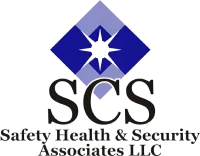Educating All Workers Through Our Safety Courses
Learning the rules and regulations for a safe and healthy workplace is extensive. Our training sessions and courses at SCS Safety Health and Security Associates LLC will empower your employees to make the right decisions when certain situations arise.


OSHA 10-Hour Course for the Construction Industry
The course includes discussions on federal and state safety requirements on construction sites. It helps construction employees, laborers, and safety teams understand how OSHA regulations affect the site and ensure they are prepared for OSHA inspections.
Contracts nowadays require employees to complete the course before being allowed access to the job site. Participants will receive an OSHA construction safety and health 10-hour card after completing the course.
Here is a list of topics covered in our 10-Hour OSHA course:
- Introduction to OSHA
- Personal Protective Equipment
- Struck By
- Caught in or between
- Health Hazards in Construction
- Electrical Safety
- Excavation
- Fall Protection
- Scaffolding
- Stairs and Ladders
- Hand and Power Tools
Daily Student Contact Hour Limit
a) Training is limited to a maximum of 7.5 student contact hours conducted per calendar day.
Therefore:
1) 10-hour classes must take a minimum of two (2) calendar days.
2) 30-hour classes must take a minimum of four (4) calendar days
OSHA 10-Hour for the General Industry
OSHA 10-Hour for the General Industry course, is one of the industry’s most requested safety training. This class is perfect for all employees in the general industry. The class gives employees a better understanding of safety and the hazards on general industry sites, such as warehouse, manufacturing facilities, and industrial plants.
Here is a list of topics covered in our 10-Hour OSHA course:
- Introduction to OSHA
- Walking Working Surfaces
- Exit Routes, Emergency Action Plans
- Electrical
- Personal Protective Equipment
- Hazard Communication
- Material Handling
- Machine Guarding
- Introduction to Industrial Hygine
- Bloodborne Pathogens
- Ergonomics
- Safety and Health Program
- Fall Protection
- Hazardous Materials
OSHA 30-Hour Course for the Construction Industry
The OSHA 30-Hour Course is a minimum of 4-day course that helps you identify the safety and health principles needed for OSHA requirements. This course is ideal for those in the construction industry, where injuries and property damage are much more common.
After the course, the participants will have an excellent working knowledge of OSHA and how it affects them in their work. They will also receive an OSHA construction safety and health 30-hour card from the US Department of Labor OSHA.
Topics include but are not limited to:
- Introduction to OSHA and the OSH Act
- Inspections, Citations, and Penalties
- OSHA Record Keeping
- Subpart C - General Provisions
- Subpart D - Occupational Health and Environmental Controls
- HAZCOM
- Subpart E - Personal Protective Equipment
- Subpart F - Fire Prevention and Protection
- Subpart H - Material Handling
- Subpart L - Scaffolds
- Subpart K - Electrical
- Subpart M - Fall Protection
- Subpart P - Excavation
- Subpart G, WO – Signs, Signals, and Barricades, Motor Vehicles, Rollover Protective Structures
- Lockout/Tagout
- Powered Industrial Trucks
- Subpart N - Cranes
- Confined Spaces
It is vital that you attend our OSHA 30-Hour Course and Training if your company position or obligation is listed below:
- Safety and Project Managers
- Management Staff
- Supervisors and Lead Persons
- Employees Involved With Safety Operations
Daily Student Contact Hour Limit a) Training is limited to a maximum of 7.5 student contact hours conducted per calendar day. Therefore: 1) 10-hour classes must take a minimum of two (2) calendar days. 2) 30-hour classes must take a minimum of four (4) calendar days

OSHA 30-Hour for the General Industry
This course provides a comprehensive safety training experience, an overview to OSHA policies, procedures and standards and basic occupations, as well as safety and health principles. Additionally, the course covers a wide range of workplace hazards covered by the OSHA standards. This course is perfect for those who are management and/or in Supervisory positions for the General Industry sites.
Daily Student Contact Hour Limit
a) Training is limited to a maximum of 7.5 student contact hours conducted per calendar day.
Therefore:
1) 10-hour classes must take a minimum of two (2) calendar days.
2) 30-hour classes must take a minimum of four (4) calendar days
- Introduction to OSHA and the OSH Act
- Managing Safety & Health
- Walking & Working Surfaces
- Exit Routes, Emergency Action Plans
- Electrical
- Personal Protective Equipment (PPE)
- Materials Handling
- Hazard Communication
- Permit-Required Confined Space
- Lockout/Tagout
- Machine Guarding
- Welding, Cutting, and Brazing
- Introduction to Industrial Hygiene
- Bloodborne Pathogens
- Ergonomics
- Fall Protection
- Safety and Health Programs
- Powered Industrial Vehicles
Training Courses for the Competent Person
At SCS Safety Health and Security Associates LLC, we also have customized safety training covering various topics. Completing these courses will meet the intent of OSHA’s Designed Competent Person.
Fall Protection Training
Fall Protection remained the top frequently cited violation for years, and OSHA has been actively campaigning for fall prevention. At SCS Safety Health and Security Associates LLC, we provide a fall protection course for competent persons.
This course provides the training required under OSHA regulations 29 CFR 1926 “Subpart M.” We aim to establish guidelines to protect all employees engaged in outdoor or indoor work activities that expose them to potential falls from elevations.
The training provides detailed coverage of the Fall Prevention & Protection Training course materials and the following program topics:
- Overview of Fall Prevention and Protection
- The Need for Fall Protection
- Hazard Analysis
- Recognition of Hazards
- Control Measures
- Annual Inspection
- Record Keeping
- Fall Prevention vs. Protection
- General Principles of Fall Protection
- Personal Fall Arrest Systems Inspection Procedures
- Fit Test, Donning Procedures, and Equipment Selection, Application, and Care
- Fall Protection on Aerial Lifts and Ladders
- Rescue
- Subpart M
Our course materials for the Fall Protection course will also include:
- Reference Fall Protection Outline
- Course Completion Certificate and Wallet Card
- PowerPoint Literature
- “Subpart M” Standards
Who Needs To Participate in the Fall Protection Course?
It is vital that you complete our Fall Protection course if your company position or obligation is listed below:
- Safety and Project Managers
- Management Staff
- Supervisors and Lead Persons
- Employees Involved With Safety Operations
Note: The course usually runs from 8:00 a.m. to 5:00 p.m. It is designed for facility and site supervisors, and workers who must also serve as the authorized person or competent person required by OSHA 1926.32(f), 1926.500, and 1910 standards.
Forklift Training
Forklift training is an OSHA-compliant program covering every aspect of lift truck training, and operators of any level of experience will benefit from the course. We employ a training and coaching method in a non-lecture format during the course.
We also provide coaching using skill-specific scenarios designed to demonstrate operator basics and highlight areas for trainee improvement. Once your skills have improved, we will present more challenging techniques.
Here is a list of topics covered during forklift training:
- OSHA Powered Industrial Truck Standard 1910.178 and 1926.602 compliance
- Evaluating Operators’ Performance
- Educating nonoperators about working safely around powered industrial trucks
- Teaching safe procedures and maintenance
- Understanding the independent instructional modules from the LTO program
- OSHA Regulations
- Pre-start safety inspections and preventive maintenance
- Worksite inspection
- Learning the basic designs and operating principles of lift trucks
- Moving with and without a load
- Moving the truck, scanning for hazards, operating safely around pedestrians, keeping a safe following distance behind other trucks, etc.
- Picking up the load, setting down the load, positioning the truck to unload, positioning the load, and moving away from the load.
- Hands-on training practical demonstrations
- Truck Driving
- Applying lift truck safety skills and operations
- Nonoperator safety training for those who work around forklifts
- Driving and steering the forklift around objects
- Maneuvering in confined spaces
- Handling different fragile or sensitive loads without damaging them
- Loading and unloading in challenging conditions
- Avoiding collisions
Course materials also include the following:
- Participant Workbooks with interactive activities, charts, and checklists
- Personalized Certificates of Completion
- Wallet cards to identify successful participants as trained operators
- Other student materials
You need to complete our Forklift training and the practical exams if your company position or obligation is listed below:
- Individuals Requiring Forklift Certification
- Forklift Operator Trainers
- Forklift Operators
- Warehouse/Shipping/Receiving Managers
- Construction Site Managers
- Safety Managers
- Safety Committee Members
- Operations Managers

Refresher Fork Lift Truck Training
An evaluation of an operator’s performance must be conducted every three years. To ensure that your operators’ skills are not compromised or wavering, we also provide refresher training to forklift operators under the following circumstances:
- Observed driving in an unsafe manner
- Involved in an accident or near-miss
- Received a hands-on evaluation that indicates unsafe driving
- Assigned to a new piece of equipment
- Subjected to a change in the workplace environment
4-Hour Confined Space Training
We train inspectors, auditors, and construction workers to identify, define, and explain hazards and acceptable corrective measures for confined spaces. This is focused on construction operations in accordance with 29 CFR 1926, Subpart AA.
The confined space training is a 4-hour classroom-based program designed to help employees understand the fundamentals of a confined space program. Attendees will be asked to supply gas monitors and tripods, so they can be familiar with the equipment.
8-Hour Confined Space Training
Our instructors also conduct an 8-hour version of the Confined Space Training for the Competent Person in the construction industry (1926.1200). This course is designed to help attendees meet the “Competent Person” status for confined space.
Topics Discussed During Confined Space Training:
- Overview of OSHA’s permit-required confined space entry standards for construction
- OSHA definitions of key terms
- Health and safety hazards associated with confined space work
- Competent person requirements to identify which confined spaces are permit-required
- OSHA requirements for reclassification of permit spaces to non-permit status
- OSHA’s alternate entry procedures for entering select permit-required confined spaces
- Signage requirements for confined spaces at construction sites
- Elements of a written confined space entry program
- Requirements for the permitting process and the entry permit
- Duties of authorized entrants, attendants, the entry supervisor, and the Competent Person
- Coordination of information among entry employers, controlling contractors, host employers, and other entities
- Confined space rescue requirements
- Personal protective equipment (PPE) requirements
- Identifying and evaluating atmospheric hazards
- Confined space ventilation techniques
Course materials also include the following:
- Participant Workbooks with interactive activities, charts, and checklists
- Personalized Certificates of Completion
- Wallet cards to identify successful participants as trained operators
- Other student materials
Phases of the Confined Space Training
Both the 4-hour and 8-hour Confined Space Training are divided into three segments:
- First segment – classroom direction where participants will have hands-on and multimedia instruction.
- Second segment – presenting attendees with setting up tripods and reviewing gas monitor procedures and personal protective equipment use (including personal fall arrest).
- Third segment – presenting a review followed by a test. Upon successful completion, workers will then set up a confined space scenario and explain rescue procedures that can be used.
Who Needs to Attend the Confined Space Training?
You need to complete our Fall Protection course if your company position or obligation is listed below:
- Safety and Project Managers
- Management Staff
- Supervisors and Lead Persons
- Employees Involved With Confined Space Operations
4-Hour Respirable Crystalline Silica Training for Competent Person
We conduct the Silica Hazards for Competent Person course to educate your employees fully. This training is helpful for an implemented Exposure Control plan as required by the OSHA Silica Health Standard for Construction, 29 CFR 1926.1153.
Your workers will learn the Health Effects of Silica, Competent Person Duties (Implementing the Exposure Control Plan), Equipment Requirements, Work Practices, Medical Surveillance, and more. After this course, they should be able to:
- List the tasks on their projects with exposure to respirable crystalline silica.
- List the five health effects of exposure to respirable crystalline silica.
- State what controls might be used on the tools or equipment
- State what medical tests will be done (on whom and when)
They would also be knowledgeable in listing the duties as they relate to:
- Inspections
- Implementing an Exposure Control Plan
- Ventilation Requirements
- Water Requirements
- Work Practices
- Respirators
- Housekeeping
Safety Meeting Topics
- Introductions to OSHA
- OSHA Recording Keeping
- Personal Protective Equipment (PPE)
- Hearing Protection
- Electrical Safety
- Lockout/tagout
- Ladder Safety
- Hazard Communications
- Respiratory Protection
- Exit Routes‑Emergency Planning‑and Fire Protection
- Fire Extinguishers
- Back Injury Prevention
- Preventing Slips-Trips and Falls
- Fall Protection
- Walking and Working Services
Mobile Elevated Work Platforms/Arial Lifts and Bucket Trucks
Aerial Lift platforms such as boom lifts, stock pickers, and scissor lifts are called Mobile Elevated Work Platforms or MEWP. MEWP’s can be found on a variety of work sites. Yes, MEWP are covered under OSHA Regulation 1926.453 and ANSI/SAIA A92.22 & A92.24 regulations. The devices are often used in place of ladders and scaffolds as they provide easier and safer access to elevated areas on worksites. Unfortunately, with the use of such devices, injuries and deaths occur. It is vital that all workers using these devices receive comprehensive training to ensure their safety and the safety of those around them.
MEWP training is divided into three different training programs with the classroom specifically covering the ANSI Training Requirements Standard ANSI 92.24. In that training program we state the requirements for the theory setting and the requirements for the practical/hands-on training. The provided manual which includes a MEWP Operator Assessment Form is used to assess not only the theory/classroom training but also the hands-on operator training. Our programs run between 4 to 6 hours long to cover both classroom and hands on sections, as well as testing knowledge and skills. While we try to cover much of each standard or regulation it is impossible to address every section/detail of every regulation, but we will customize to your organization.
OSHA’s Trenching and Excavation Competent Person Standards. 29 CFR 1926.650. 6‑hour Course.
The Competent Person Training for Trenching and Excavation Course, an on-site training program to ensure proper compliance with OSHA Standard 1926.650 and 1926.652. This essential course can save lives, time, and money for your company by helping your hard-working employees to avoid mistakes, at the same time also help your company avoid OSHA citations and costly penalties.
Our professional trainer comes to your site and conducts the Competent Person for Excavation Training course for your group. The class is based on the requirements of Subpart P of the Federal OSHA CFR 1926 construction standards for trenching and excavations. We will also address nuances that may appear in OSHA regulations regarding their excavation standards, where applicable. This excavation competent person class consists of PowerPoint instruction, video, workshops, and a test to keep the trainees engaged.
NFPA 70E Electrical Safety Training
This 4-to-6-hour course covers all the requirements a qualified person needs to know including OSHA and NFPA 70 E 2021 electrical safe work practices. The detailed course material is designed for all personnel who work on, around, or near any type of electrically energized equipment. Topics discussed include electrical hazards, the safe installation of electrical equipment, arc flashes, PPE, proper electrical work practices and procedures.
The new NFPA 70E 2021 requirements, rules, and regulations as required by the OSHA Electrical Safety-Related Work Practices Standard 1910.331 through 1910.335, will be discussed. The primary goal of this course is to keep electrical workers safe, updated, and equip them with lifesaving knowledge.

Take Advantage of Our Classes and Training Programs
Please get in touch with us for a quote for our classes or to schedule a course for your company. We can also help you identify which courses are required for your company and workers.
